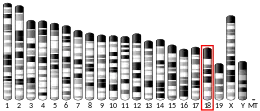TRPP3
Polycystic kidney disease 2-like 2 protein (PKD2L2) also known as transient receptor potential polycystic 5 (TRPP5) is a protein that in humans is encoded by the PKD2L2 gene.[5]
| PKD2L2 | |||||||||||||||||||||||||||||||||||||||||||||||||||
|---|---|---|---|---|---|---|---|---|---|---|---|---|---|---|---|---|---|---|---|---|---|---|---|---|---|---|---|---|---|---|---|---|---|---|---|---|---|---|---|---|---|---|---|---|---|---|---|---|---|---|---|
| Identifiers | |||||||||||||||||||||||||||||||||||||||||||||||||||
| Aliases | PKD2L2, TRPP5, polycystin 2 like 2, transient receptor potential cation channel | ||||||||||||||||||||||||||||||||||||||||||||||||||
| External IDs | OMIM: 604669 MGI: 1858231 HomoloGene: 22812 GeneCards: PKD2L2 | ||||||||||||||||||||||||||||||||||||||||||||||||||
| |||||||||||||||||||||||||||||||||||||||||||||||||||
| |||||||||||||||||||||||||||||||||||||||||||||||||||
| |||||||||||||||||||||||||||||||||||||||||||||||||||
| |||||||||||||||||||||||||||||||||||||||||||||||||||
| |||||||||||||||||||||||||||||||||||||||||||||||||||
| Wikidata | |||||||||||||||||||||||||||||||||||||||||||||||||||
| |||||||||||||||||||||||||||||||||||||||||||||||||||
TRPP5 is a member of the transient receptor potential channel family of proteins.
See also
References
- GRCh38: Ensembl release 89: ENSG00000078795 - Ensembl, May 2017
- GRCm38: Ensembl release 89: ENSMUSG00000014503 - Ensembl, May 2017
- "Human PubMed Reference:". National Center for Biotechnology Information, U.S. National Library of Medicine.
- "Mouse PubMed Reference:". National Center for Biotechnology Information, U.S. National Library of Medicine.
- Veldhuisen B, Spruit L, Dauwerse HG, Breuning MH, Peters DJ (December 1999). "Genes homologous to the autosomal dominant polycystic kidney disease genes (PKD1 and PKD2)". Eur. J. Hum. Genet. 7 (8): 860–72. doi:10.1038/sj.ejhg.5200383. PMID 10602361.
Further reading
- Li Q, Liu Y, Zhao W, Chen XZ (2002). "The calcium-binding EF-hand in polycystin-L is not a domain for channel activation and ensuing inactivation". FEBS Lett. 516 (1–3): 270–8. doi:10.1016/S0014-5793(02)02513-9. PMID 11959145. S2CID 1812119.
- Strausberg RL, Feingold EA, Grouse LH, et al. (2002). "Generation and initial analysis of more than 15,000 full-length human and mouse cDNA sequences". Proc. Natl. Acad. Sci. U.S.A. 99 (26): 16899–903. Bibcode:2002PNAS...9916899M. doi:10.1073/pnas.242603899. PMC 139241. PMID 12477932.
- Stayner C, Zhou J (2001). "Polycystin channels and kidney disease". Trends Pharmacol. Sci. 22 (11): 543–6. doi:10.1016/S0165-6147(00)01832-0. PMID 11698076.
- Guo L, Schreiber TH, Weremowicz S, et al. (2000). "Identification and characterization of a novel polycystin family member, polycystin-L2, in mouse and human: sequence, expression, alternative splicing, and chromosomal localization". Genomics. 64 (3): 241–51. doi:10.1006/geno.2000.6131. PMID 10756092.
This article is issued from Wikipedia. The text is licensed under Creative Commons - Attribution - Sharealike. Additional terms may apply for the media files.



